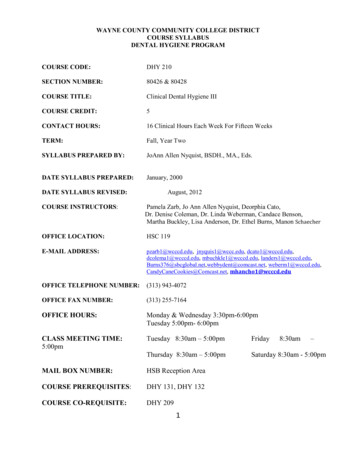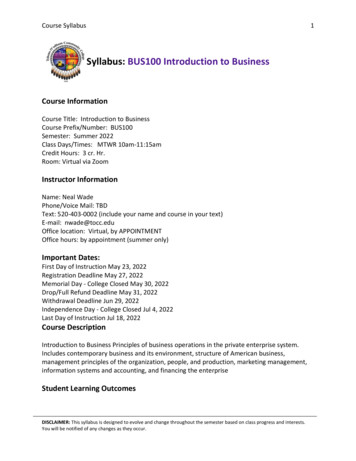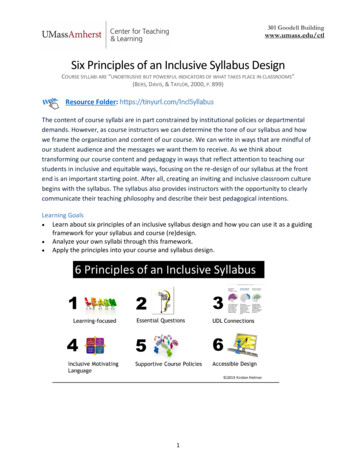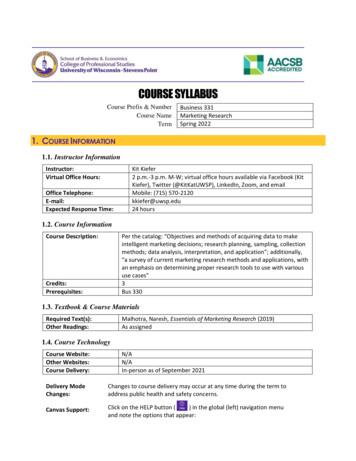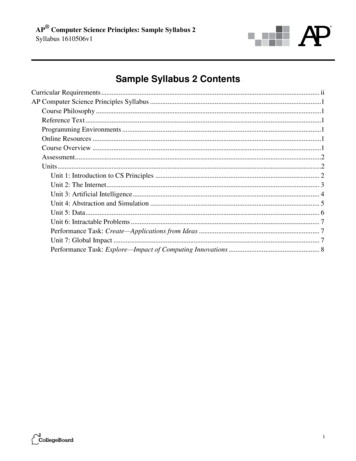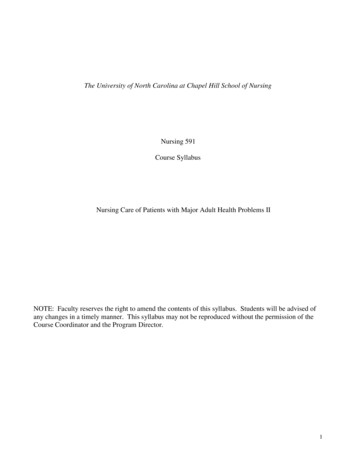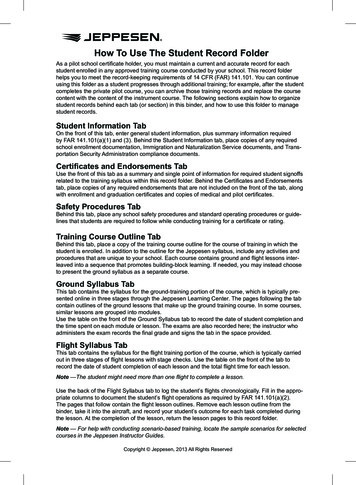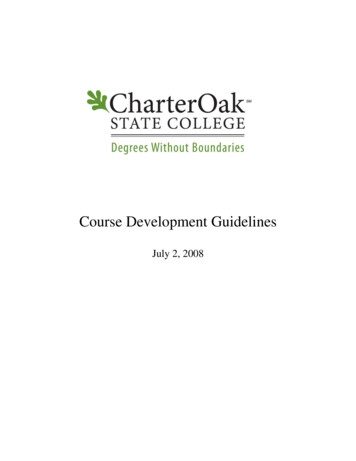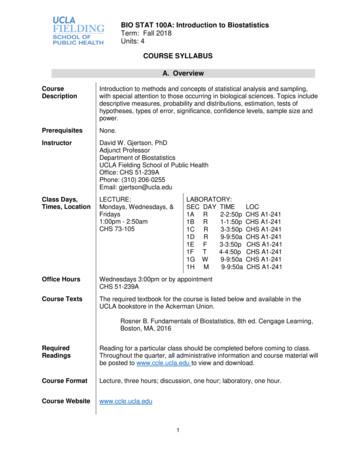
Transcription
BIO STAT 100A: Introduction to BiostatisticsTerm: Fall 2018Units: 4COURSE SYLLABUSA. OverviewCourseDescriptionIntroduction to methods and concepts of statistical analysis and sampling,with special attention to those occurring in biological sciences. Topics includedescriptive measures, probability and distributions, estimation, tests ofhypotheses, types of error, significance, confidence levels, sample size andpower.PrerequisitesNone.InstructorDavid W. Gjertson, PhDAdjunct ProfessorDepartment of BiostatisticsUCLA Fielding School of Public HealthOffice: CHS 51-239APhone: (310) 206-0255Email: gjertson@ucla.eduClass Days,Times, LocationLECTURE:Mondays, Wednesdays, &Fridays1:00pm - 2:50amCHS 73-105Office HoursWednesdays 3:00pm or by appointmentCHS 51-239ACourse TextsThe required textbook for the course is listed below and available in theUCLA bookstore in the Ackerman Union.LABORATORY:SEC DAY TIME1A R2‐2:50p1B R1‐1:50p1C R3‐3:50p1D R9‐9:50a1E F3‐3:50p1F T4‐4:50p1G W9‐9:50a1H M9‐9:50aLOCCHS A1‐241CHS A1‐241CHS A1‐241CHS A1‐241CHS A1‐241CHS A1‐241CHS A1‐241CHS A1‐241Rosner B. Fundamentals of Biostatistics, 8th ed. Cengage Learning,Boston, MA, 2016RequiredReadingsReading for a particular class should be completed before coming to class.Throughout the quarter, all administrative information and course material willbe posted to www.ccle.ucla.edu to view and download.Course FormatLecture, three hours; discussion, one hour; laboratory, one hour.Course Websitewww.ccle.ucla.edu1
(Continued)BIO STAT 100A: Introduction to BiostatisticsTerm: Fall 2018Units: 4UCLA ADAPolicyStudents needing academic accommodations based on a disabilityshould contact the Center for Accessible Education (CAE) at (310) 8251501 or in person at Murphy Hall A255. When possible, students shouldcontact the CAE within the first two weeks of the term as reasonablenotice is needed to coordinate accommodations. For more informationvisit www.cae.ucla.edu.ADA ContactNickey WoodsCenter for Accessible EducationA255 Murphy HallPhone: (310) 825-1501TTY / TTD: (310) 206-6083Fax: (310) 825-9656InclusivityUCLA’s Office for Equity, Diversity, and Inclusion provides resources,events, and information about current initiatives at UCLA to supportequality for all members of the UCLA community. I hope that you willcommunicate with me or your TA if you experience anything in thiscourse that does not support an inclusive environment, and you can alsoreport any incidents you may witness or experience on campus to theOffice of Equity, Diversity, and Inclusion on their website(https://equity.ucla.edu/).2
(Continued)BIO STAT 100A: Introduction to BiostatisticsTerm: Fall 2018Units: 4B. Learning ObjectivesCompetencies addressed in this course, learning objectives mapped to these competencies, and assessments that assess thesecompetencies:Course Learning Objectives1. Introduction to statistics and its utility in the scientific,particularly the public health, environment.2. Develop analytical skills involving distributions andmeasures of central tendency and spread. Understandbasic informatic techniques and how they can be applied topublic health situations.3. Understand the basic concepts of probability with respectto how they apply to the fundamental interpretation ofstatistical data and sampling distributions.4. To develop analytical skills involving the normaldistribution and other key probability distributions.5. To understand the concepts of estimation, confidenceand confidence intervals and how they are used instatistical inference. To understand the difference betweenconfidence and probability.6. To infer single population means and proportions withpoint and interval estimates. To perform hypotheses testsand to interpret results for a data set. To compare twopopulation means with point and interval estimates. Toperform hypotheses tests on the difference of twopopulation means and two population proportions.CEPH Learning Experiences &CompetenciesLE2. Identify the core functionsof public health and the 10Essential Services.AssessmentsLE6. Explain the criticalimportance of evidence inadvancing public healthknowledge.C2. Select quantitative andqualitative data collectionmethods appropriate for a givenpublic health context. C3. Analyze quantitative andqualitative data usingbiostatistics, informatics,computer-based programmingand software, as appropriate. 7. Introduction to techniques of statistical inference that donot require the use of standard assumptions such as thenormal distribution.3 Assignment 3 (Exercises 1, 2,3, 7, and 9)Laboratory Two (Section C2)Laboratory Three (Section C5)Laboratory Five (Section C7)Laboratories One throughSeven (Analysis Section)
(Continued)BIO STAT 100A: Introduction to BiostatisticsTerm: Fall 2018Units: 4C. Course Assignments & Exams1)Laboratory assignments: In computer lab sessions, seven assignments will be givento assess basic techniques for analyzing data using STATATM, doing online researchand examining relevant publications for statistical content. Labs are an integral part ofthe course with content corresponding to lecture topics. Each lab assignment alsocontains exercises specifically designed to assess the CEPH competencies listed inSection B of this syllabus.2)Homework assignments: Homework sets will be distributed but will not be graded.They are, however, essential to learning the course material and will be reviewed duringdiscussion sessions. Laboratory assignments are graded (see evaluations below).Students are urged to seek help from instructor/TA when assigned problems do notsatisfactorily answer questions or explain troublesome concepts.3)Midterm examinations: Midterm I given on November 2, 2018, 1-2:50p and Midterm IIgiven on November 30, 2018, 1-2:50p. Rooms TBA4) Final examination: Given on December 12, 2018, 8-11a. Rooms TBASTUDENT EXPECTATIONSAttendance and Class Participation Policy:Lecture attendance is not recorded; however, laboratory attendance is marked (Weeks 2-8) andforms an important element of a class participation grade. All students are expected tocomplete reading before coming to lab sessions, ask relevant questions, and contribute to groupdiscussions. Throughout the quarter, all administrative information and course material will beposted to http://gjertson.bol.ucla.edu/b100af18/ to view and download.Grading:All competencies must be completed in order to receive a class grade, then evaluations arecompiled using the following weights: Laboratory assignmentsMidterm examsFinal exam30%30%40%100%Grading Scale: The raw grading scale for the course is shown below. (Extra credit may beapplied to adjust grades.)Grade Point: 4.0 4.0 3.67 3.33 3.0 2.67 2.33 2.0 1.67 1.33 1.0 0.67FinalPercentage:LetterGrade:010083745998-90 90-88 87-8479-77 77-7569-65 64-6054-50 4099807055A AA-B BB-4C CC-D DD-F
(Continued)BIO STAT 100A: Introduction to BiostatisticsTerm: Fall 2018Units: 4D. Course Policies & UCLA PoliciesMessage about Academic Integrity to all UCLA Students from UCLA Dean ofStudents: UCLA is a community of scholars. In this community, all members including faculty,staff and students alike are responsible for maintaining standards of academic honesty. As astudent and member of the University community, you are here to get an education and are,therefore, expected to demonstrate integrity in your academic endeavors. You are evaluated onyour own merits. Cheating, plagiarism, collaborative work, multiple submissions without thepermission of the professor, or other kinds of academic dishonesty are considered unacceptablebehavior and will result in formal disciplinary proceedings usually resulting in suspension ordismissal.Forms of Academic Dishonesty: As specified in the UCLA Student Conduct Code, violationsor attempted violations of academic dishonesty include, but are not limited to, cheating,fabrication, plagiarism, multiple submissions or facilitating academic dishonesty: Allowing another person to take a quiz, exam, or similar evaluation for you Using unauthorized material, information, or study aids in any academicexercise or examination – textbook, notes, formula list, calculator, etc.Unauthorized collaboration in providing or requesting assistance, such assharing informationUnauthorized use of someone else’s data in completing a computer exerciseAltering a graded exam or assignment and requesting that it be regraded Plagiarism: Presenting another’s words or ideas as if they were one’s own Submitting as your own through purchase or otherwise, part of or an entire workproduced verbatim by someone elseParaphrasing ideas, data or writing without properly acknowledging thesourceUnauthorized transfer and use of someone else’s computer file as your ownUnauthorized use of someone else’s data in completing a computer exerciseMultiple Submissions: Submitting the same work (with exact or similar content) in more thanone class without permission from the instructor to do so. This includes courses you arecurrently taking, as well as courses you might take in another quarterFacilitating Academic Dishonesty: Participating in any action that compromises the integrity ifthe academic standards of the University; assisting another to commit an act of academicdishonesty Taking a quiz, exam, or similar evaluation in place of another personAllowing another student to copy from youProviding material or other information to another student withknowledge that such assistance could be used in any of theviolations stated above (e.g., giving test information to students inother discussion sections of the same course)Altering data to support researchPresenting results from research that was not performedCrediting source material that was not used for research5
(Continued)BIO STAT 100A: Introduction to BiostatisticsTerm: Fall 2018Units: 4While you are here at UCLA, if you are unsure whether what you are considering doing ischeating, don’t take chances,– ask your professor. In addition, avoid placing yourself insituations which might lead your professor to suspect you of cheating.Alternatives to Academic Dishonesty Seek out help – Meet with your professor, ask for assistance as needed.Ask for an extension – if you explain your situation to your professor, she/he might beable to grant you an extended deadline for an upcoming assignment.See a counselor at Student Psychological Services, and/or your school, college ordepartment – UCLA has many resources for students who are feeling the stresses ofacademic and personal pressures.If you would like more information, please come see us at the Dean of Students’ Office in 1206Murphy Hall, call us at (310) 825-3871 or visit their website at www.deanofstudents.ucla.edu.6
(Continued)BIO STAT 100A: Introduction to BiostatisticsTerm: Fall 2018Units: 4E. Course OutlineThis schedule may change as the semester progresses, according to student enrollment and needs.DATEFri.TOPICREADING (Rosner 2016)9/28/2018 Course OrientationWeek 1Mon.10/1/2018 Lecture 1. Introduction & Descriptive StatisticsIntroduction1. Population and parameters2. Sample and statistics3. Study design and qualitative/quantitative datacollectionData presentation4. Scales and measurement5. Percentiles6. Exploratory data analysisCh 1 & 2Wed.10/3/2018 Lecture 2. Descriptive StatisticsData presentation1. Graphical techniques and tables2. Multi-variable techniquesCh 2Fri.10/5/2018 Lecture 3. Descriptive StatisticsData presentation1. Histograms with unequal length intervalsNumerical summaries of data2. Measures of location3. Measures of variation4. ExampleCh 2Week 2 (Lab Session One)Mon.10/8/2018 Lecture 4. Descriptive StatisticsSummary measures for grouped data1. Means and SDs2. Medians and IQRs3. ExampleUniform changes to data4. Adding to and multiplying by constantsRates5. RatesWed. 10/10/2018 Lecture 5. Ideas of Probability & Sampling ChancesProbability1. Three definitions2. Basic concepts3. Adding probabilities4. Independence5. Conditional probabilitiesFri.10/12/2018 Discussion 1.7Ch 2Ch 13, §5Ch 3
(Continued)BIO STAT 100A: Introduction to BiostatisticsTerm: Fall 2018Units: 4DATETOPICREADING (Rosner 2016)Week 3 (Lab Session Two)Mon. 10/15/2018 Lecture 6. Ideas of Probability & Sampling ChancesProbability1. Odds and relative risk2. Likelihoods3. Bayes theorem4. Prevalence and incidenceCh 3Wed. 10/17/2018 Lecture 7. Ideas of Probability & Sampling ChancesChance sampling1. Quotas and surveys2. Bias3. Simple random sample4. Randomly selecting numbers5. General probability sampling6. Cluster and stratified samplingExperimental design7. Single versus comparative study8. Design of experiments9. Principles of experimental designCh 6, §1-4Fri.Ch 13, §1-410/19/2018 Discussion 2.Week 4 (Lab Session Three)Mon. 10/22/2018 Lecture 8. Ideas of Probability & Sampling ChancesExperimental design1. Type of experimentsSampling distributions2. Continuous and discrete distributionsi. Binomial distributionii. Normal distribution3. Random variablesCh 4 & 5Wed. 10/24/2018 Lecture 9. Ideas of Probability & Sampling ChancesRules for random variables1. Means of random variables2. Variances of random variablesNormal distribution3. General properties4. Standard normal distribution5. Standardization of units6. Finding areas under normal curvesCh 5Fri.10/26/2018 Discussion 3.8
(Continued)BIO STAT 100A: Introduction to BiostatisticsTerm: Fall 2018Units: 4DATETOPICREADING (Rosner 2016)Week 5 (Lab Session Four)Mon. 10/29/2018 Lecture 10. Ideas of Probability & Sampling ChancesNormal distribution1. Chance errors2. Properties of the sample mean3. Sampling distribution of the mean4. Central limit theorem5. Normal approximation to binomial6. Examples7. Normal probability plotsCh 5Wed. 10/31/2018 Review 1.Fri.11/2/2018 Midterm Examination I. *** Rooms TBA ***Week 6 (Lab Session Five)Mon.11/5/2018 Lecture 11. Introduction to Statistical InferenceGeneral techniques1. Statistical inference: techniques2. Point estimates3. Interval estimates4. Length of intervals5. Interval estimates: sample sizeCh 6Wed.11/7/2018 Lecture 12. Statistical Inference of MeansOne-sample1. Hypothesis testing: tests of significance2. Example3. Notations and definitions4. Test for μ, σ known5. Computation of power6. Relationships among α, power and nCh 7Fri.11/9/2018 Lecture 13. Statistical Inference of MeansOne-sample1. Power curves2. Confidence intervals for μ. σ is unknown3. Properties of the t-distribution4. Finding areas in t-distribution5. Hypothesis testing for μ, σ is unknown6. Power and t-testsCh 7Week 7 (Lab Session Six for Sections 1A-1G)Mon. 11/12/2018 No Class – Veterans DayWed. 11/14/2018 No Class – Gjertson away, labs meetFri.11/15/2018 No Class – Gjertson away, labs meet9
(Continued)BIO STAT 100A: Introduction to BiostatisticsTerm: Fall 2018Units: 4DATETOPICREADING (Rosner 2016)Week 8 (Lab Session Six for Section 1H)Mon. 11/19/2018 Lecture 14. Statistical Inference of MeansOne-sample1. Inference for nonnormal populationsTwo-sample2. Inference on two population means3. Estimates of independent groups’ μ1- μ24. Known variances5. Unknown but equal variances6. Unknown and unequal variances7. Hypothesis testing for μ1- μ2Ch 9, §1-2Ch 8Ch 9, §4Wed. 11/21/2018 Discussion 4.Fri.11/23/2018 No Classes – Thanksgiving HolidayWeek 9 (Lab Session Seven)Mon. 11/26/2018 Lecture 15. Statistical Inference of MeansTwo-sample1. Inference for two independent nonnormalpopulations2. Inference on two population means:dependent samplesWed. 11/28/2018 Review 2.Fri.11/30/2018 Midterm Examination II. *** Rooms TBA ***Week 10 (Lab Session Review)Mon.12/3/2018 Lecture 16. Statistical Inference of ProportionsCategorical data1. Multinomial experiment2. Chi-squareOne-sample3. Inference on a single population proportioni. Confidence intervalsii. Hypothesis testingCh 7Wed.12/5/2018 Lecture 17. Statistical Inference of ProportionsTwo-sample1. Inference concerning the difference in twoindependent proportions.2. Difference in proportions derived from asingle sample.Ch 10Fri.12/7/2018 Review 3.Handouts 1 & 2Week 11 FinalWed. 12/12/2018 Final Examination (8-11a). *** Rooms TBA ***10
C. Course Assignments & Exams 1) Laboratory assignments: In computer lab sessions, seven assignments will be given to assess basic techniques for analyzing data using STATATM, doing online research and examining relevant publications for statistical content. Labs are an integral part of the course with content corresponding to lecture topics.




